Reading the writings on the wall in poll-bound Punjab, I am conflicted on what to choose first: Politics, electoral prospects or the far deeper social change that is political as well as religious.
Frankly, that distinction doesn’t even particularly apply to Punjab, as combining religion and political power is enshrined in the Miri-Piri doctrine central to Sikhism. It has only become stronger over the centuries since it was formalised by the sixth Guru – Guru Hargobind (1595-1644). He ritually wore two swords: one of Miri (political/temporal power) and the second of Piri (faith and spirituality).
Since this instalment in the WritingsOnTheWall series is based mostly on travels through the Majha region, as the mostly agricultural, super-fertile expanse west of the Beas river and bordering Pakistani Punjab is called and has almost every inch marked by the deeds and footsteps of the great Gurus, I’d rather begin with the latter. You will also find some of the holiest Sikh shrines here — Golden Temple at Amritsar and the replica Gurdwara at nearby Tarn Taran which is also called Darbar Sahib, and has the largest sarovar (holy water tank) of any gurdwara.
With so much religiosity meshed with politics, this has always been a fertile ground for radicalism as well. The important and worrying thing is that at least three of the five contenders in these elections are working on relighting the fires that lie dormant for three decades. It is not a message you will read first on a wall, but see in an exhibit — the large model of the holy Akal Takht, as it looked after the battering by the Army’s Vijayanta tanks and 25-pounder guns during Operation Bluestar almost exactly in this week 40 years ago.
The model has been placed strategically between the Akal Takht and the Golden Temple so a devotee going to either sees this first. Who’s put it there? The Shiromani Gurdwara Parbandhak Committee (SGPC). Who rules the SGPC? The Shiromani Akali Dal, the pre-eminent Sikh party now battling for survival, its vote share falling below 20 percent for the first time.
Some, it’s been losing to the Congress; much more was taken in its devastation by the AAP in the last assembly elections; and now, there is a threat from a combination of new and old radical leaders. It lost its most vital ally in the BJP. The curious thing is that the Akalis are not the only party playing with this fire. Even the BJP, whose cadres lost so many lives fighting militancy, has jumped in. At a big rally for its candidate former and much respected top IFS officer Taranjit Singh Sandhu, before BJP president J.P. Nadda arrived, the party’s formidable Sikh leader Manjinder Singh Sirsa reminded his audience of how “the Congress party had attacked your temple with tanks and artillery”.
Four decades after that most traumatic week in Punjab the Akali Dal sees the political compulsion to bring it back. The BJP, desperate to make a mark and with the vengeance of a jilted old lover, is joining the bandwagon.
Both former partners are competing in this with Simranjit Singh Mann, the former IPS officer seeking re-election in distant Sangrur, Amritpal Singh (currently detained in Dibrugarh) in Khadoor Sahib next door and Sarabjit Singh in Faridkot (reserved). Sarabjit, by the way, is the son of Beant Singh, who was shot dead on the spot for assassinating Indira Gandhi. Radicalism is back, especially in zones where Sikhs form a large rural majority, and three of the five prominent political forces in this election are playing with it. Now, you can see why that model of a wrecked Akal Takht Sahib is today the starkest writing on the Punjab wall.
Also Read: Education, aspiration & 3 de-hyphenations: A changing Kashmir votes and vents
Amritpal Singh, whose organisation is called, somewhat blandly, Waris Punjab De (inheritors of Punjab), is just 31 and a pretender to the cult of Jarnail Singh Bhindranwale (he, too, rose in his 30s). He made waves in Punjab last year, and unlike Bhindranwale who never used the word Khalistan, he flaunted it liberally.
Days after a daring raid on a big border police station at Ajnala to free a follower, he was arrested 23 April last year and taken away to Dibrugarh in the eastern corner of Assam, probably the prison most distant from his village Jallupur Khera in Tarn Taran district.
Belying all apprehensions, there were almost no protests, no trouble. His ‘legend,’ it seemed, was over. Just a bubble that grew too fast, and then burst. It is now making a return. He is contesting from his own borough, Khadoor Sahib constituency (where his village falls), as an independent. He is, however, supported by Simranjit Singh Mann. He doesn’t have his symbol, but posters, booklets, pronouncements, all speak of it. Mann tells me Amritpal wanted support and he said yes. And then adds as a calm afterthought: “Although I do not think he even needs it. He’s winning anyway.”
You want to see how? Join with me the road show his mother is leading, seeking votes for him in the Khadoor Sahib constituency next to Amritsar, bordering Pakistan all along its western limits. His flag is the most colourful, with blue, saffron and yellow, and his symbol, fittingly, the microphone. Slogans are nothing you can object to.
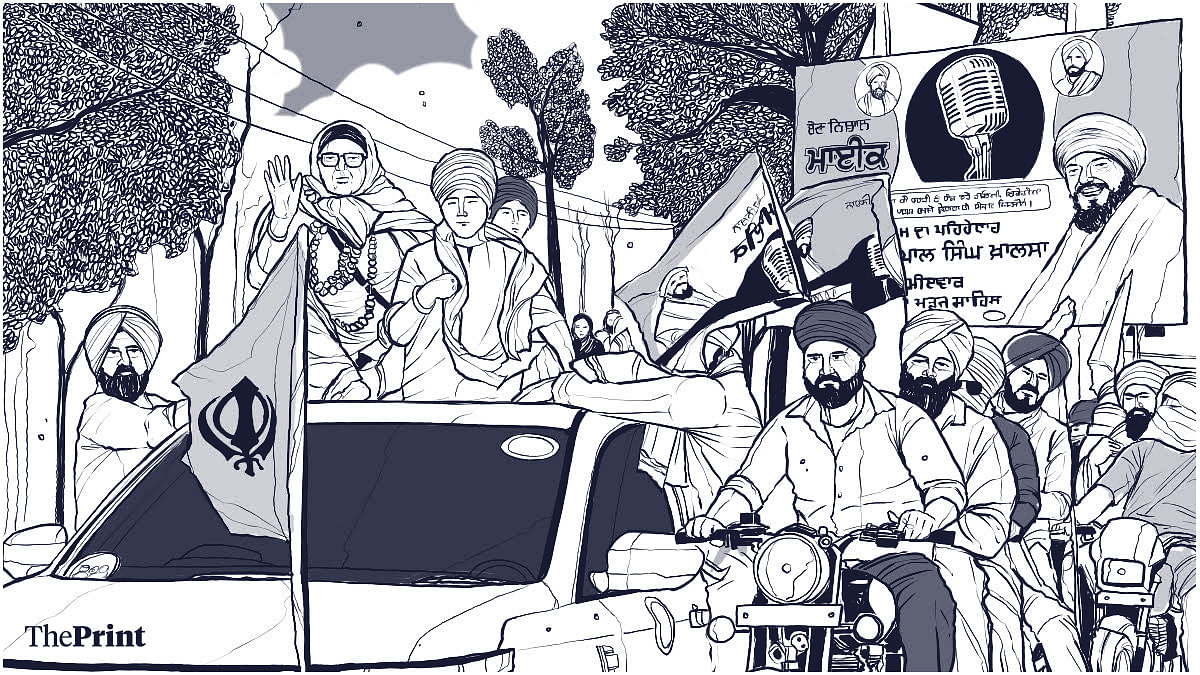
It’s 3pm, with a merciless sun and mercury at its peak. As the road show goes past villages, more vehicles join in. The procession grows and it mostly has young Sikhs, some Nihangs, and there is no religious slogan.
Who’s paying for your campaign, I ask Amritpal’s father Tarsem Singh, as the group winds up at his home, a langar running outside. “We have nothing, the sangat (community) contributes. Then, there’s the Akal Purakh (almighty).” You really think the government will release your son if he wins, I take the conversation forward. “Well, they have to then think about what they will be saying to the nearly 5 lakh mostly young people who will vote for him,” the former crane driver in Mumbai, Bahrain and Dubai, has clarity.
He fields the ‘K’ question with a straight face. “We want everybody to be pure, that is, khalis. That’s what we mean by Khalistan.”
Much of the logic over “dhakka” (injustice) to Sikhs is put forward by Swaran Singh ‘Golden,’ one of Amritpal’s many uncles. It’s the story you’ve heard many times, if you stopped by these parts 40 years ago: until 1849, the Sikhs were an independent nation, the British conquered them by deceit; even Kashmir was ours; it’s written in our scriptures that China and Russia will join hands and fight the West; there will be a world war and the map of the world will be redrawn. It’s been written. Nobody can stop what’s been written. It IS bound to happen.
Now do you recall that part-time actor and Waris Punjab De founder Deep Sidhu’s little speech at the farm protest that went viral: this isn’t just about the farmers. It is about changing geopolitics, and so on.
In fact, this time, Amritpal isn’t promising anything you and I could object to or describe as radical. Bringing those guilty of sacrilege to justice, a sincere fight against drug culture, prevention of conversions (to Christianity) with allurement and deceit and interestingly, opening trade with Pakistan and prevention of emigration away from Punjab are among his 10-point charter. Nothing any other party in Punjab won’t promise. Except perhaps the last!
I take my mind back to how this countryside looked three to four decades ago. The same fields, crops, almost entirely agrarian society, indifferent education and formal skills, emigration the only ambition. But for that, you have to first pass IELTS (International English Language Testing System), a basic test of English language usage that most flunk. The dress, demeanour, talk, constant harking back to scriptures by even the young, it is as if the region has stayed frozen in time even as a lot of the country has moved on. When you think regional imbalances next time, don’t just think coastal states versus the Hindi heartland. Rural Punjab will be somewhere in the middle. Except, its rural working-class dreams of migrating not to another Indian state but to Canada. I will explain why.
Agricultural income and remittances have enabled families to build sizeable houses. As you drive past them, you’d be taken aback by haveli-sized houses, jutting out of corn and fodder fields this May. But what would the Tarn Taran Gen-Z do here? It is as if entrepreneurship and urbanisation have passed rural Punjab by. Most of these young people won’t make the cut for new-age jobs in India.
They only look at Canada for low-value jobs. That’s also their leap into urbanisation of a kind. It is this frustration, pent-up anger among a proud people who feel they’ve been left out, that’s driving the drug culture at one end, and radicalism on the other.
Beyond the scriptural prophecies, the contemporary clamour is all about Modi, RSS and their ‘homogenisation project’. The line you’d hear most often across age groups is: don’t ask us if we want Khalistan. Just tell us, if there can be a Hindu Rashtra, what’s wrong with a Sikh nation?
Exhausted at the end of his campaign in Sangrur, Simranjit Singh Mann, now in his 80th year, puts it more elaborately. “Minorities are being targeted in Manipur, so many tribals, including women, have just been killed in the name of Naxalism in Chhattisgarh, Muslims are under attack,” he says. “While in the past, India only gave information to foreign governments against Sikh activists, now they just go and shoot them. Why shouldn’t the Sikhs, as a small minority, be also thinking hard about their options?”
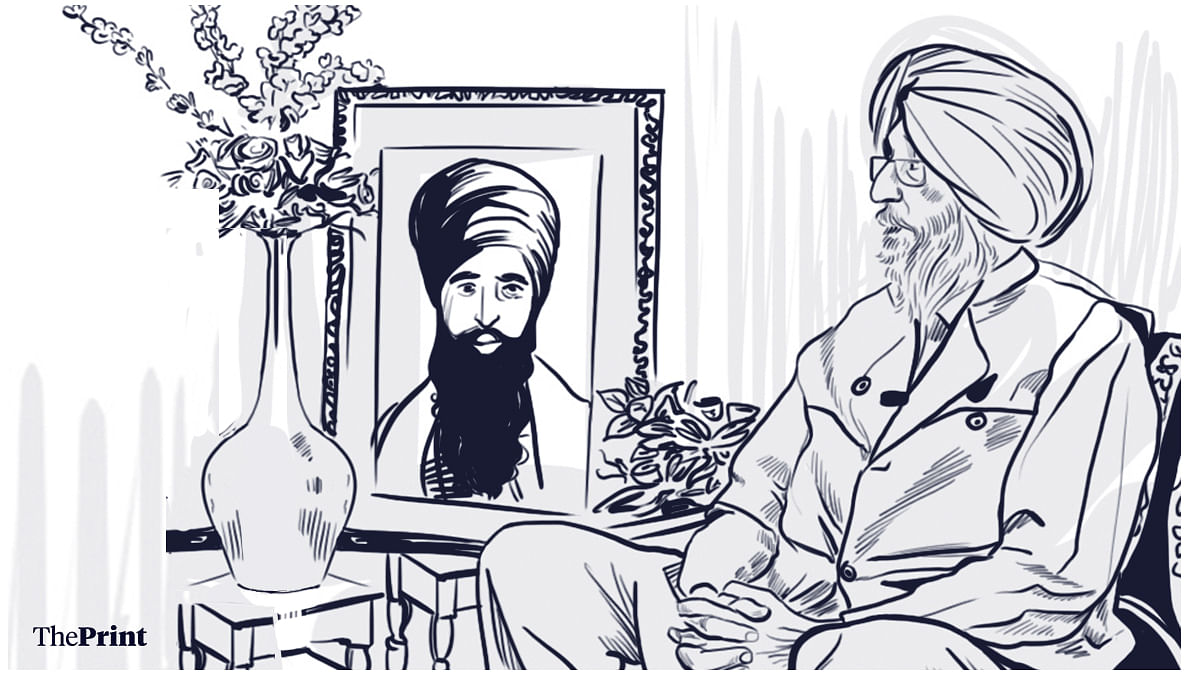
Also Read: Yogi’s cows, Modi’s houses, Akhilesh’s jobs: Why this is a more ‘normal’ Uttar Pradesh election
From Campaign Amritpal to Comrade Jagdish Kaur is a radical shift in more ways than one. Four decades ago, we knew Bhikhiwind as a small border village near Khem Karan where the most storied tank battle (Asal Uttar) of the 1965 war took place. It was also among the most affected by militancy. This is the region where terror groups didn’t defy the government. They were the government by 1990, the bloodiest year in Punjab insurgency, taking a toll of 5,070 civilian lives (South Asia Terrorism Portal).
The village has grown into a small town with private hospitals, a couple of pizza/burger shops — one even called Canada Burger — and large schools. One has so many ACs jutting out of its classroom windows that you’d confuse it with a 2-star hotel of the kind you find close to airports in medium-sized cities. A more modest one, Evergreen Senior Secondary school — this is where the co-founder, Comrade Balwinder Singh, was assassinated allegedly by hitmen of the ‘Khalistan Commando Force’ on 16 October 2020. The National Investigation Agency (NIA) subsequently busted the module and eight alleged killers and conspirators are now facing trial. Jagdish Kaur is struggling to keep the school going. Nobody wants to send children to a state board school when CBSE ones are available. Plus, she’s got no ACs in classrooms.
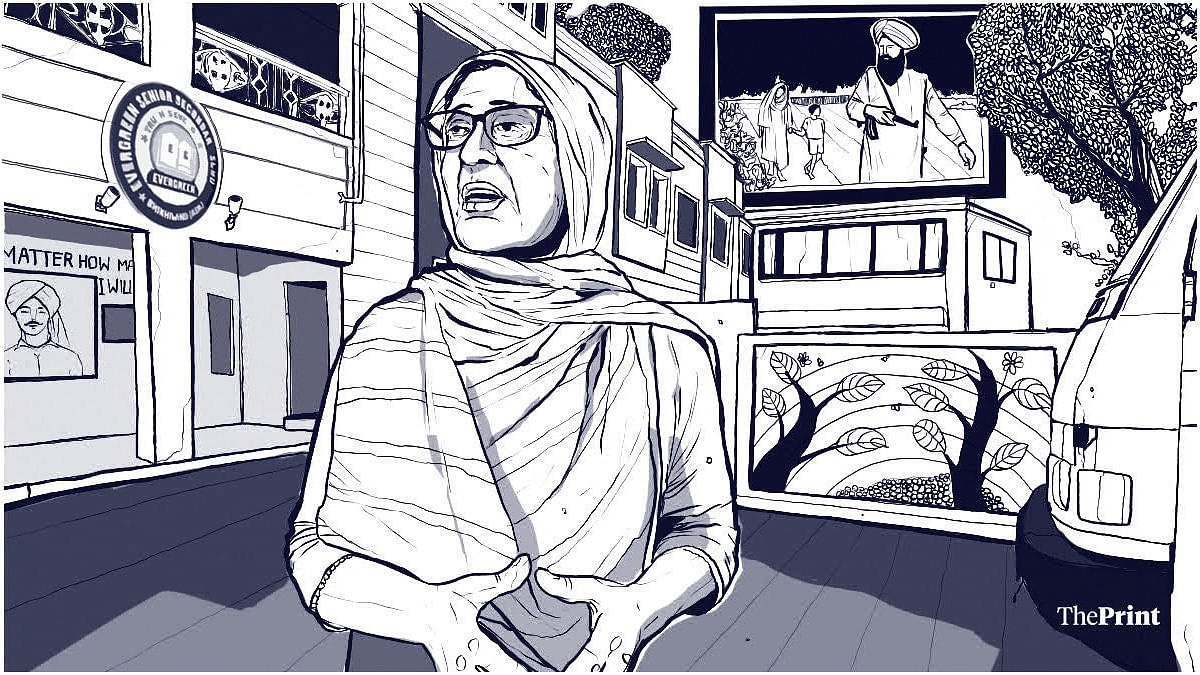
Going back to 1990, besides the 5,070 civilians, the Punjab Police lost 452 lives. That’s more than what any Indian uniformed force has lost in any year anywhere. New Delhi had India’s weakest government ever, and as V.P. Singh waffled, the police found some innovations. One of these enabled the rise of incredibly courageous people like Balwinder Singh and wife Jagdish Kaur. Both members of the CPM had ‘comrade’ prefixed to their names. One of the least acknowledged stories of that era is the fight ‘comrades’ put up on the ground. The police armed them, and mostly left them to their fate. More than 200 ‘comrades’ died fighting. More of that, I keep back for another piece in my other occasional series, First Person/Second Draft.
For now, let’s go back to the story of December 1990 when, along with photographer Prashant Panjiar, we reported a cover story for India Today, travelling through Punjab in what the headline aptly described as ‘Rule of the Gun’. See the cover pictures of both the English and Hindi editions. The armed couple on the tractor are the comrades Balwinder and Jagdish. The little boy is son Gagandeep. The family was targeted by militants almost on a daily basis and fought off 42 attacks, two of them with rocket launchers. Both Balwinder and Jagdish Kaur were awarded Shaurya Chakras.
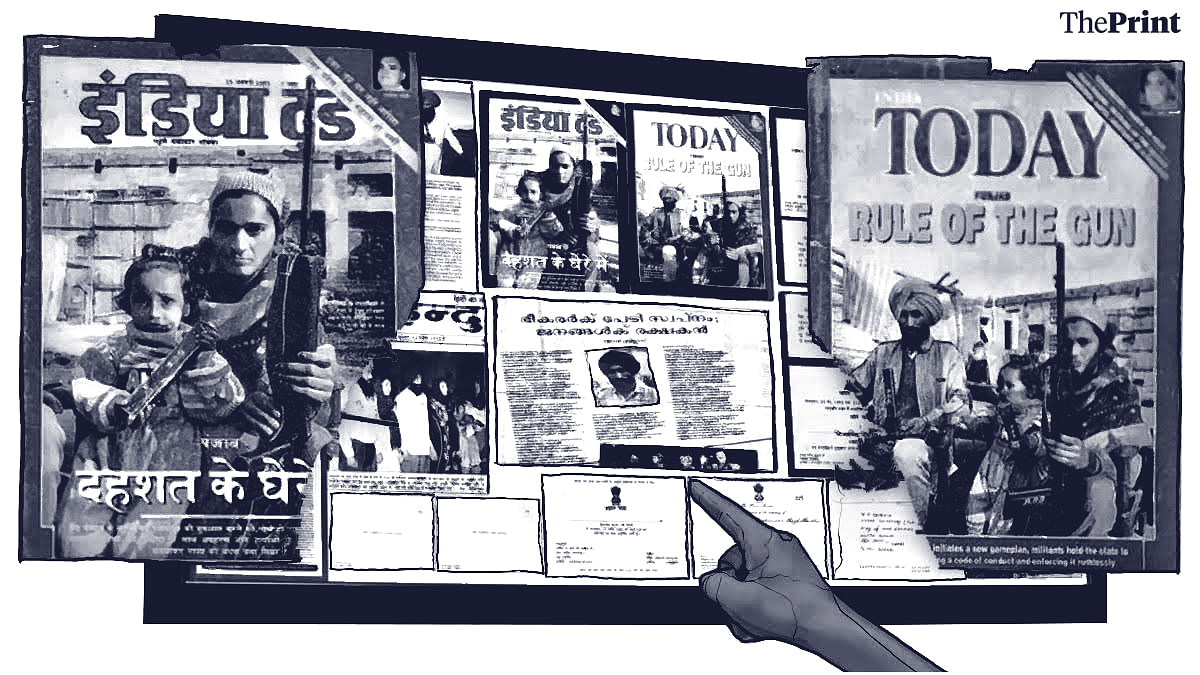
The entrance to that unpaved street was guarded by another ‘comrade’, Major Singh, who too was targeted. An assassination on him was attempted through a milkman carrying a bomb in his milk bucket. The bomb went off prematurely killing the ‘milkman’. We witnessed and reported on the couple, with pictures of how the entire family, including toddler Gagandeep, was part of the fight. He was already adept at refilling the carbine magazines within his little fingers as firefights went on for hours. That war was won by the good side by 1994 and Punjab has enjoyed total peace since. But the ‘enemy’ has a long memory. That’s why Balwinder and wife always remained marked targets.
Jagdish Kaur talks about the past and the present with an equanimity you only get from decades of struggle. Her husband, she said, used to receive threats, the latest just about 10 days before he was killed. He emailed a complaint to the police headquarters and even got an acknowledgement. But nobody probably suspected the killers were so close. Even now, she says the family has been given a police gunman, but all he’s armed with is an ancient carbine and there is always the fear that even if he dropped it accidentally, it will fire off a couple of rounds hitting just anybody. The request that he be given an AK-47 isn’t being granted.
The surviving comrade walks us around the school, showing bullet marks on the walls where Balwinder was shot. Police CCTV cameras, main and a backup, track every move. Gagandeep, now well into his 30s, joins in the walkaround with his wife. For Jagdish, one regret besides security and the lack of any government grant or support after fellow Shaurya Chakra awardee Balwinder’s assassination is the decline of the Left, especially her CPM in the post-Harkishan Singh Surjeet era. She lives in a zone where the greatest challenge to India’s unity was fought between 1981 and 1994. The zone isn’t anywhere near returning to that mayhem. The older generation that survived it still has enough nightmares not to ever return to it. But, the economic stagnation, disillusionment of the youth, drugs, infinitesimal strike rate with that Canadian dream, separatist social media propaganda (mostly emerging from Canada), rising religiosity and leaders like Amritpal have made it ripe for renewed trouble.
It is for all of the reasons you have read so far that we gave this socio-religious churning the precedence over immediate electoral politics in this edition of WritingsOnTheWall. The politics, however, is also more exciting — and challenging — than almost anywhere in the country. This is Punjab, after all. It’s a small state only in that it sends only 13 MPs to the Lok Sabha. We need not waste your time repeating why it’s so important.
How exciting and challenging the election is, you will read on the “walls” if you make a minute’s halt at Amritsar’s Rialto Chowk, named so after an old cinema hall. There are hoardings, in series, from the AAP, Congress, Shiromani Akali Dal and the BJP, all contesting this seat. There is a smaller one for Amritpal, with his “mike” symbol in the neighbouring Khadoor Sahib.
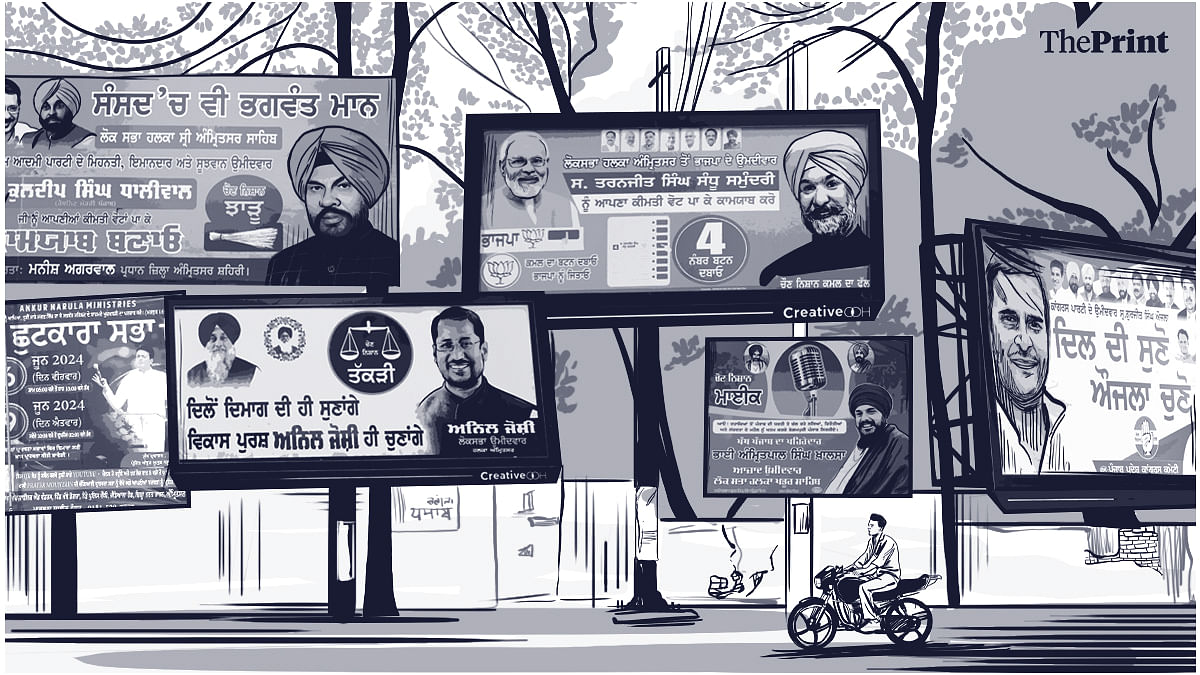
There are two others in the same that complete the picture. Ten of Punjab’s seats have a four-way fight between the Congress, Akalis, AAP and BJP. In three, make it five-way with a significant radical contesting, too: Amritpal in Khadoor Sahib, Simranjeet Singh Mann in Sangrur and Indira assassin Beant Singh’s son Sarabjeet Singh in Faridkot (the last two in Malwa region). In a four- or five-way fight, with no overarching theme and total absence of Modi factor, any party that gets about 2.5 lakh votes (out of approximately a million cast) can win. Punjab is one state in the north to fully duck two Modi waves yet in 2014 and 2019, and this year looks the same. The Akali-BJP split has increased the division of votes. It might weaken both but, ironically, the division can also help a candidate here, another there. At just 2.5 lakh votes, you can be first past the post. Only a reckless and foolhardy analyst will dare to call this election.
There’s another hoarding in the same row from “Purohit Ankur Yousuf Narula Ministries” plugging his “Chhutkara Sabha” (Good Riddance Congregations) to help you spiritually rid yourself of disease, drugs, other worldly troubles. Purohit is just code for pastor. Rural Punjab has seen a massive growth of Hindu and Sikh-named pastors as Chitleen K. Sethi of ThePrint reports in this brilliant story. They are also widely accused of converting Sikhs to Christianity. It is a big issue in today’s politics, feeding into radicalism. It feeds into Sikhs fears over their dwindling numbers and Amritpal is promising to contain these.
Further, in the same wall of hoardings, you will also see one with the giant picture of that shattered Akal Takht in 1984. Political divisions, Hindu-Sikh (BJP-Akali) split, fear of conversions and Operation Bluestar as triggers for new radicalism personified by candidate Amritpal Singh, you can read all of this in writings on just this one ‘wall’, in the heart of Amritsar. Maybe, we’ve been wrong to call poll-bound Punjab a confusing state.
Also Read: Modi’s Hindutva 2.0 written on Varanasi walls: Temple restoration, not mosque demolition



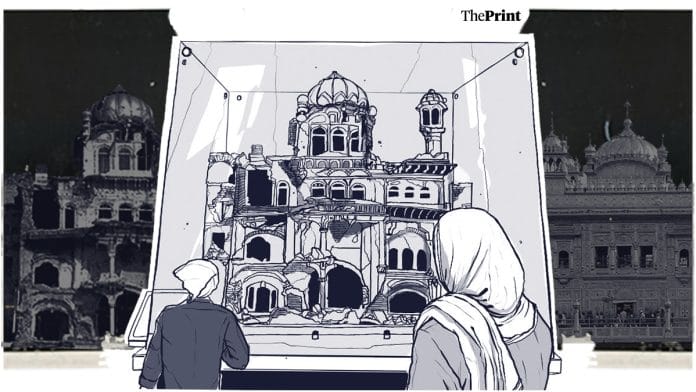



There is no doudt in it.
Indian Communists and especially Panjabi Communists are establised and trained by Nehru-RussianKGB. main purpose to establish these Nehru-RussianKGB trained Communists was/is to control minorities like Sikhs and others in India to establish Hindi, Hindutva, Hindurastra/Hindustan, which is the fascist wish of Mughals and Brahmanical system.
Hindutva is a Mughals concept which is completely adopted by Brahmanical system to establish Hindi, Hindutva, Hindurastra/Hindustan.
Modern days Mughals/Barhmanical system Hindutva.
Type 1 Hindutva RSS-BJP
Type 2 Hindutva AryaSmaj-HinduMahaSabha-Cogress-AAP-NehruKGB TrainedCommunists-ManubadiAmbedkaries.
Type 2 Hindutva always works against Sikhs and Panjab to help Type 1 Hindutva to establish Mughals/Barhmanical system wish of Hindi, Hindutva, Hindurastra/Hindustan.
and in case of Sikhs and Panjab, This Hindutva used and is using Type 2 Hindutvies of Nehru-RussianKGB Trained Panjabi Communists against Sikhs and Panjab to establish Hindi, Hindutva, Hindurastra/Hindustan.
ਸ਼ੇਖਰ ਗੁਪਤਾ ਤੋਂ ਲੈਕੇ ਹਿੰਦੂ ਰਾਜਨਿਤਕ ਇਲੀਟ ਜਮਾਤ ਨੂੰ ਪੰਜਾਬ ਵਿੱਚ ਅੰਮ੍ਰਿਤਪਾਲ ਸਿੰਘ ਦਾ ਉਭਾਰ ਭਾਰਤ ਏਕਤਾ ਅਖੰਡਤਾ ਉੱਤੇ ਖਤਰਾ ਲੱਗਦਾ ਹੈ ,ਪਰ ਦੂਸਰੇ ਪਾਸੇ ਓਹਨਾਂ ਨੂੰ ਕਾਮਰੇਡ ਬਲਵਿੰਦਰ ਟਾ_ _ਟ ਦਾ ਟੱਬਰ ਮਹਾਨ ਦੇਸ਼ ਭਗਤ ਲਗਦਾ ਹੈ,
ਭਾਰਤ ਵਿਚ ਹਿੰਦੂ ਰਾਜਨੀਤਕ ਉਭਾਰ ਨੂੰ ਹੀ ਰਾਸ਼ਟਰਵਾਦ ਕਿਹਾ ਜਾਂਦਾ ਹੈ , ਲਿਬਰਲ ਤੋਂ ਲੈਕੇ ਅਖੌਤੀ ਧਰਮ ਨਿਰਪੇਖ ਜਾਂ ਕਾਮਰੇਡ ਲਈ ਏਕਤਾ ਅਖੰਡਤਾ ਦਾ ਮਤਲਬ ਇੱਥੇ ਦੀ ਬਹੁਗਿਣਤੀ ਦੀ ਲੱਤ ਹੇਠਾਂ ਲੰਘਣਾ ਜਾਂ ਇਸਦੇ ਦਾਬੇ ਦੀ ਮਾਨਤਾ ਤੱਕ ਸੀਮਤ ਹੈ,
ਅੱਜ ਵੀ ਭਾਰਤ ਵਿਚ ਲੋਕਤੰਤਰ ਦਾ ਮਤਲਬ ਬਹੁਗਿਣਤੀ ਵਾਦ ਹੈ, ਦਲਿਤ ਰਾਜਨੀਤੀ ਵੀ ਕਿਤੇ ਨਾ ਕਿਤੇ ਇਸੇ ਬਹੁਗਿਣਤੀ ਵਾਦ ਦਾ ਹਿੱਸਾ ਬਣ ਕੇ ਸਿਰਫ ਰਾਖਵਾਂਕਰਨ ਰਾਹੀਂ ਮਿਲੇ ਖ਼ਾਸ ਹੱਕਾਂ ਨੂੰ ਸੁਰੱਖਿਅਤ ਰੱਖਣ ਤੱਕ ਸੀਮਤ ਹੈ ਅਤੇ ਉਸੇ ਏਜੰਡੇ ਅਧੀਨ ਉਹ ਸੰਵਿਧਾਨ ਨੂੰ ਇੱਕ ਰੱਬੀ ਅਤੇ ਪਵਿੱਤਰ ਕਿਤਾਬ ਬਣਾਉਣ ਵਿੱਚ ਲੱਗੀ ਹੋਈ ਹੈ , ਦੂਸਰੇ ਪਾਸੇ ਅਜਿਹੀ ਜਮਾਤ ਨੂੰ ਦੂਸਰੇ ਧਿਰਾਂ ਦੇ ਵੱਖ ਇਲੈਕਟੋਰੇਟ ਮੰਗਣ ਦੇ ਅਧਿਕਾਰ ਵਿਚ ਵੱਖ ਵਾਦ ਲਗਦਾ ਹੈ, ਹਾਲਾਂਕਿ ਡਾਕਟਰ ਅੰਬੇਦਕਰ ਖੁੱਦ ਦਲਿਤਾਂ ਲਈ ਵੱਖ ਇਲੈਕਟੋਰੇਟ ਢਾਂਚਾ ਹੀ ਮੰਗਦੇ ਸਨ ਪਰ ਮਹਾਤਮਾ ਗਾਂਧੀ ਦੀ ਹਿੰਦੂ ਹਿਤਾਂ ਦੀ ਰਾਜਨੀਤਕ ਸਮਝ ਨੇ ਡਾਕਟਰ ਅੰਬੇਦਕਰ ਨੂੰ ਇਸ ਮੰਗ ਤੋਂ ਦਬਾਅ ਪਾ ਕੇ ਪਾਸੇ ਕਰ ਦਿੱਤਾ
ਭਾਰਤ ਦੀ ਬਹੁਗਿਣਤੀ ਅੱਗੇ ਸਿੱਖਾਂ ਵਰਗੇ ਛੋਟੇ ਅਤੇ ਮਾਮੂਲੀ ਜਿਹਾ ਆਬਾਦੀ ਸਮੂਹ ਕਿਸੇ ਵੀ ਥਾਂ ਚੋਣ ਪ੍ਰਣਾਲੀ ਵਿਚ ਨਹੀਂ ਟਿਕ ਸਕਦਾ , ਚੰਡੀਗੜ੍ਹ ਦੀ ਮਿਸਾਲ ਸਭ ਦੇ ਸਾਹਮਣੇ ਹੈ ਕੇ ਕਿਵੇਂ ਆਬਾਦੀ ਬੰਬ ਜਿਹੜਾ ਕੇ ਭਾਰਤ ਵਿਚ ਬਹੁਗਿਣਤੀ ਦਾ ਸਭ ਤੋਂ ਵੱਡਾ ਹਥਿਆਰ ਹੈ ਉਹ ਚਲਾ ਕੇ ਕਿਸ ਤਰ੍ਹਾਂ ਇੱਕ ਇਲਾਕੇ ਦਾ ਭਾਸ਼ਾਈ ਰੂਪ ਹੀ ਖਤਮ ਕਰ ਸੁੱਟਿਆ , ਇਹ ਪ੍ਰਯੋਗ ਹੁਣ ਪੰਜਾਬ ਵਿੱਚ ਚਲਾਉਣ ਦੀ ਵੱਡੇ ਪੱਧਰ ਤੇ ਤਿਆਰੀ ਹੈ
2027 ਸਿੱਖਾਂ ਕੋਲ ਸਿਰਫ ਆਖਰੀ ਮੌਕਾ ਹੋਵੇਗਾ ਜਿਸ ਵਿਚੋਂ ਓਹ ਆਪਣੇ ਖਿੱਤੇ ਵਿਚ ਆਪਣੇ ਹਿਤਾਂ ਲਈ ਕੁਝ ਕਰ ਸਕਦੇ ਹਨ ਇਸ ਤੋਂ ਬਾਅਦ ਇਸ ਖਿੱਤੇ ਦਾ ਆਬਾਦੀ ਖਾਕਾ ਬਦਲ ਜਾਵੇਗਾ , ਪਰਵਾਸ ਪੰਜਾਬ ਨੂੰ ਕਿਸ ਤਰ੍ਹਾਂ ਅਸਰ ਕਰ ਰਿਹਾ ਹੈ ਇਹ ਗੰਭੀਰਤਾ ਨਾਲ ਸੋਚਣ ਵਾਲੀ ਗੱਲ ਹੈ, ਜਿੱਥੇ ਪੰਜਾਬੀ ਸਿੱਖ ਬਾਹਰ ਜਾ ਰਿਹਾ ਹੈ ਓਥੇ ਪੰਜਾਬੀ ਹਿੰਦੂ ਵੀ ਬਾਹਰ ਜਾ ਰਿਹਾ ਹੈ, ਪਰ ਦੋਹਾਂ ਵਿਚ ਫਰਕ ਇਹ ਹੈ ਕਿ ਸਿੱਖ ਜਿਹੜਾ ਕੇ ਸਿਰਫ ਪੰਜਾਬ ਵਿੱਚ ਹੀ ਬੈਠਾ ਹੈ ਅਤੇ ਬਹੁਗਿਣਤੀ ਮਾਣ ਰਿਹਾ ਹੈ , ਉਸ ਵਲੋਂ ਖਾਲੀ ਕੀਤੀ ਥਾਂ ਨੂੰ ਭਰਨ ਲਈ ਕੋਈ ਸਿੱਖ ਨਹੀਂ ਹੈ , ਉਸਦੇ ਮੁਕਾਬਲੇ ਪੰਜਾਬੀ ਹਿੰਦੂ ਵਲੋਂ ਖਾਲੀ ਕੀਤੀ ਥਾਂ ਭਰਨ ਲਈ ਪ੍ਰਵਾਸੀ ਹਿੰਦੂ ਆਬਾਦੀ ਉਹ ਥਾਂ ਭਰ ਰਹੀ ਹੈ, ਜਿਹੜੀ ਕੇ ਪੰਜਾਬੀ ਸੂਬੇ ਦੀ ਹੋਂਦ ਨੂੰ ਇਕ ਤਰ੍ਹਾਂ ਖ਼ਤਮ ਕਰ ਰਹੀ ਹੈ | ਦੂਸਰੇ ਪਾਸੇ ਪੰਜਾਬ ਦੀਆਂ ਰਾਜਨੀਤਕ ਪਾਰਟੀਆਂ ਹਨ ਜਿਹੜੀਆਂ ਕੇ ਸਥਾਨਕ ਲੋਕਾਂ ਦੇ ਹਿੱਤ ਪਾਸੇ ਰੱਖ ਕੇ ਇਸ ਖੇਤਰੀ ਸੰਤੁਲਨ ਨੂੰ ਖਰਾਬ ਕਰਨ ਲਈ ਵੋਟ ਬੈਂਕ ਦੀ ਰਾਜਨੀਤੀ ਕਰ ਰਹੀਆਂ ਹਨ |
ਇਸ ਵਿੱਚ ਕੋਈ ਸ਼ੱਕ ਨਹੀਂ ਹੈ।
ਭਾਰਤੀ ਕਮਿਊਨਿਸਟ ਅਤੇ ਖਾਸ ਕਰਕੇ ਪੰਜਾਬੀ ਕਮਿਊਨਿਸਟ ਨਹਿਰੂ-ਰੂਸੀ ਕੇਜੀਬੀ ਦੁਆਰਾ ਸਥਾਪਿਤ ਅਤੇ ਸਿਖਲਾਈ ਪ੍ਰਾਪਤ ਹਨ। ਇਹਨਾਂ ਨਹਿਰੂ-ਰੂਸੀ ਕੇ.ਜੀ.ਬੀ. ਦੇ ਸਿੱਖਿਅਤ ਕਮਿਊਨਿਸਟਾਂ ਨੂੰ ਸਥਾਪਿਤ ਕਰਨ ਦਾ ਮੁੱਖ ਮਕਸਦ ਹਿੰਦੀ, ਹਿੰਦੂਤਵ, ਹਿੰਦੂਰਾਸ਼ਟਰ/ਹਿੰਦੁਸਤਾਨ, ਜੋ ਕਿ ਮੁਗਲਾਂ ਅਤੇ ਬ੍ਰਾਹਮਣਵਾਦੀ ਪ੍ਰਣਾਲੀ ਦੀ ਫਾਸ਼ੀਵਾਦੀ ਇੱਛਾ ਹੈ, ਨੂੰ ਸਥਾਪਿਤ ਕਰਨ ਲਈ ਭਾਰਤ ਵਿੱਚ ਸਿੱਖਾਂ ਅਤੇ ਹੋਰਾਂ ਘੱਟ ਗਿਣਤੀਆਂ ਨੂੰ ਕੰਟਰੋਲ ਕਰਨਾ ਸੀ/ਹੈ।
ਹਿੰਦੂਤਵ ਇੱਕ ਮੁਗਲ ਸੰਕਲਪ ਹੈ ਜੋ ਹਿੰਦੀ, ਹਿੰਦੂਤਵ, ਹਿੰਦੂਰਾਸ਼ਟਰ/ਹਿੰਦੁਸਤਾਨ ਦੀ ਸਥਾਪਨਾ ਲਈ ਬ੍ਰਾਹਮਣਵਾਦੀ ਪ੍ਰਣਾਲੀ ਦੁਆਰਾ ਪੂਰੀ ਤਰ੍ਹਾਂ ਅਪਣਾਇਆ ਗਿਆ ਹੈ।
ਅਜੋਕੇ ਸਮੇਂ ਦਾ ਮੁਗਲ/ਬਰਹਮਣਵਾਦੀ ਸਿਸਟਮ ਹਿੰਦੂਤਵ।
ਟਾਈਪ 1 ਹਿੰਦੂਤਵ ਆਰਐਸਐਸ-ਭਾਜਪਾ
ਟਾਈਪ 2 ਹਿੰਦੂਤਵਾ ਆਰਿਆਸਮਾਜ-ਹਿੰਦੂ ਮਹਾਸਭਾ-ਕੋਗ੍ਰੇਸ-ਆਪ-ਨੇਹਰੂਕੇਜੀਬੀ ਸਿਖਲਾਈ ਪ੍ਰਾਪਤ ਕਮਿਊਨਿਸਟ-ਮਨੁਬਾੜੀ ਅੰਬੇਡਕਰੀਆਂ।
ਟਾਈਪ 2 ਹਿੰਦੂਤਵ ਹਮੇਸ਼ਾ ਸਿੱਖਾਂ ਅਤੇ ਪੰਜਾਬ ਦੇ ਵਿਰੁੱਧ ਕੰਮ ਕਰਦਾ ਹੈ ਤਾਂ ਜੋ ਟਾਈਪ 1 ਹਿੰਦੂਤਵ ਨੂੰ ਹਿੰਦੀ, ਹਿੰਦੂਤਵ, ਹਿੰਦੂਰਾਸ਼ਟਰ/ਹਿੰਦੁਸਤਾਨ ਦੀ ਮੁਗਲ/ਬਰਹਮਣਵਾਦੀ ਪ੍ਰਣਾਲੀ ਦੀ ਇੱਛਾ ਨੂੰ ਸਥਾਪਿਤ ਕਰਨ ਵਿੱਚ ਮਦਦ ਕੀਤੀ ਜਾ ਸਕੇ।
ਅਤੇ ਸਿੱਖਾਂ ਅਤੇ ਪੰਜਾਬ ਦੇ ਮਾਮਲੇ ਵਿੱਚ, ਇਸ ਹਿੰਦੂਤਵ ਨੇ ਹਿੰਦੀ, ਹਿੰਦੂਤਵ, ਹਿੰਦੁਸਤਾਨ/ਹਿੰਦੁਸਤਾਨ ਦੀ ਸਥਾਪਨਾ ਲਈ ਨਹਿਰੂ-ਰੂਸੀ ਕੇਜੀਬੀ ਦੇ ਸਿੱਖਿਅਤ ਪੰਜਾਬੀ ਕਮਿਊਨਿਸਟਾਂ ਦੇ ਟਾਈਪ 2 ਹਿੰਦੂਤਵੀਆਂ ਨੂੰ ਸਿੱਖਾਂ ਅਤੇ ਪੰਜਾਬ ਵਿਰੁੱਧ ਵਰਤਿਆ ਅਤੇ ਵਰਤ ਰਿਹਾ ਹੈ।
punjab’s story is same as kerala… no jobs, no companies or industries, no interest by govts at state and central levels… with people’s interest for earn more leading to decline in agriculture and moving towards overseas employments…local people only have to look for govt. jobs, otherwise, get out of state and country…that is what is happening for decades… even sports at one time were favourites, but now nothing as no one gets quick money… some get in sports quota the jobs, but again its bribes that come in…. in reality, this is the same across the country….
Disturbing column. May those who are meant to worry about these things pay heed.